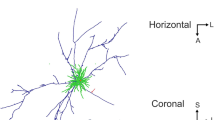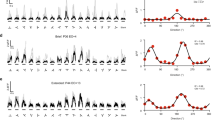Abstract
Electrophysiological and pharmacological studies1–6 indicate that the specific responses of most visual cortical neurones depend on intracortical γ-aminobutyric acid (GABA)-mediated inhibitory processes. GABAergic interneurones have been visualized in all layers of the mammalian cerebral cortex by immunocytochemical methods7,8 and by high-affinity uptake of exogenous 3H-GABA9–11. It is recognized that GABA is synthesized and specifically accumulated by aspinous and sparsely spinous stellate cells, but there is no evidence available to indicate whether the laminar distribution of these cells and their axonal projections are related to the known role of GABAergic inhibitory processes in the generation of responses in visual cortical cells. It would therefore be of value to delineate the intracortical projection of the axons of different types of GABA-releasing neurones in regions of cortex where the receptive field properties of the neurones, and their modification by GABA antagonists, are well known. The selective high-affinity uptake of labelled GABA has been useful in delineating GABAergic systems12: recently, it has been shown that exo-genous 3H-GABA is specifically taken up and transported retrogradely by axons of neurones thought to be GABA-ergic13,14. Using microinjections of 3H-GABA into different layers of the monkey visual cortex, we have examined the pattern of labelled neurones. We report here a bimodal distribution of GABA-accumulating neurones after injection into layers V and VI, with one group of neurones around the injection site and the other directly above, in layers II and III. We provide evidence that the latter neurones are non-pyramidal cells, probably labelled by retrograde axonal transport from the deep layers.
This is a preview of subscription content, access via your institution
Access options
Subscribe to this journal
Receive 51 print issues and online access
$199.00 per year
only $3.90 per issue
Buy this article
- Purchase on Springer Link
- Instant access to full article PDF
Prices may be subject to local taxes which are calculated during checkout
Similar content being viewed by others
References
Rose, D. & Blakemore, C. Nature 249, 375–377 (1974).
Sillito, A. M. J. Physiol., Lond. 250, 305–329 (1975).
Sillito, A. M. J. Physiol., Lond. 271, 699–720 (1977).
Sillito, A. M. J. PhysioL., Lond. 289, 33–53 (1979).
Sillito, A. M., Kemp, J. A., Milson, J. A. & Berardi, N. Brain Res. 194, 517–520 (1980).
Tsumoto, T., Eckart, W. & Creutzfeldt, O. D. Expl Brain Res. 34, 351–365 (1979).
Hendrickson, A. E., Hunt, S. P. & Wu, J. Y. Nature 292, 605–607 (1981).
Riback, C. E. J. Nèurocytol. 7, 461–479 (1978).
Chronwall, B. & Wolff, J. R. J. comp. Neurol. 190, 187–208 (1980).
Hökfelt, T. & Ljungdahl, A. Expl Brain Res. 14, 354–362 (1972).
Somogyi, P., Freund, T. F., Halász, N. & Kisvárday, Z. F. Brain Res. (in the press).
Iversen, L. L. in Handbook of Psychopharmacology Vol. 9 (eds Iversen, L. L., Iversen, S. D. & Snyder, S. H.) 41–68 (Plenum, New York, 1978).
Streit, P. J. comp. Neurol. 191, 429–463 (1980).
Streit, P., Knecht, E. & Cuénod, M. Science 205, 306–307 (1979).
Jaffe, E. H. & Cuello, A. C. Brain Res. 186, 232–238 (1980).
Somogyi, P., Hodgson, A. J. & Smith, A. D. Neuroscience 4, 1805–1852 (1979).
Lund, J. S. & Boothe, R. G. J. comp. Neurol. 159, 305–334 (1975).
Fisken, R. A., Garey, L. J. & Powell, T. P. S. Phil Trans. R. Soc. B272, 487–536 (1975).
Sloper, J. J., Hiorns, R. W. & Powell, T. P. S. Phil. Trans. R. Soc. B285, 141–173 (1979).
Davis, T. L. & Sterling, P. J. comp. Neurol. 188, 599–627 (1979).
LeVay, S. J. comp. Neurol. 150, 53–86 (1973).
Ramon y Cajal, S. Histologie du Système Nerveux de l'Homme et des Vertébrés Vol. 2 (Maloine, Paris, 1911).
Valverde, F. Anat. Embryol. 154, 305–334 (1978).
Szentágothai, J. Proc. R. Soc. B201, 219–248 (1978).
Somogyi, P. & Cowey, A. J. comp. Neurol. 195, 547–566 (1981).
Ribak, C. E., Harris, A. B., Vaughn, J. E. & Roberts, E. Science 205, 211–213 (1979).
Hubel, D. H. & Wiesel, T. N. Proc. R. Soc. B198, 1–59 (1977).
Author information
Authors and Affiliations
Rights and permissions
About this article
Cite this article
Somogyi, P., Cowey, A., Halász, N. et al. Vertical organization of neurones accumulating 3H-GABA in visual cortex of rhesus monkey. Nature 294, 761–763 (1981). https://doi.org/10.1038/294761a0
Received:
Accepted:
Issue Date:
DOI: https://doi.org/10.1038/294761a0
This article is cited by
-
Lateral inhibition in visual cortex of migraine patients between attacks
The Journal of Headache and Pain (2013)
-
Imaging of radiocarbon-labelled tracer molecules in neural tissue using accelerator mass spectrometry
Nature (1996)
-
GABAergic neurons in the barrel cortex of the mouse: An analysis using neuronal archetypes
Journal of Neurocytology (1987)
-
Theorien zur Organisation und Funktion des Gehirns
Naturwissenschaften (1985)
Comments
By submitting a comment you agree to abide by our Terms and Community Guidelines. If you find something abusive or that does not comply with our terms or guidelines please flag it as inappropriate.



